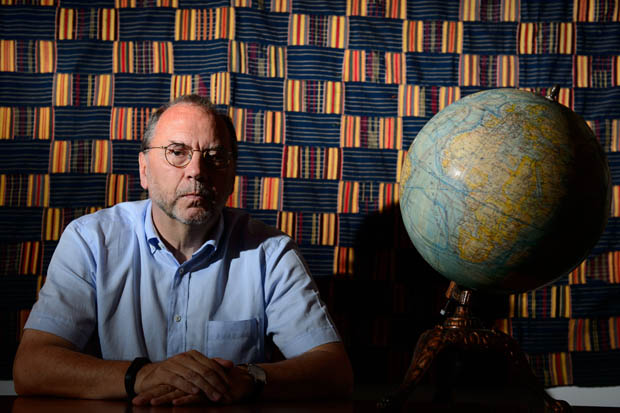By some quirk of fate, just as news reached the papers that the Scottish nurse who had contracted Ebola while working in Sierra Leone was now recovered, the guest on that Radio 4 staple Desert Island Discs was the scientist who first identified the virus. This gave a programme that can seem rather outdated and superficial a whole new resonance, providing the back story to the news, adding that frisson of inquiry, of revelation. Did Professor Peter Piot, as a young researcher working at Antwerp’s Institute of Tropical Medicine almost 40 years ago, realise he was seeing something quite new and so dangerous? ‘It looked like war,’ he told Kirsty Young after giving us a vivid description of how the virus arrived at the lab in a shiny blue Thermos flask, ‘just like the kind you use for coffee’, brought by a Belgian pilot straight from Kinshasa, capital of what was then Zaire.
‘Was he wearing gloves?’ asked Young. ‘Of course,’ said Piot, who for the past four years has been director of the London School of Hygiene and Tropical Medicine. That was not the problem. The flask contained a blood sample from a nun who had fallen sick while nursing others in the hospital she helped to run in an isolated community in Zaire where no attention was paid to the basic rules about reusing syringes, let alone the strict conditions necessitated by Ebola’s ferocious power. That’s probably why the virus was allowed to take hold, says Piot, after being caught originally by someone from an infected bat, who then passed on the illness at their funeral. Death rites in West Africa involve careful and communal washing of the body and much hugging as a way of saying farewell. It has been very hard to change these behaviours. Touching is part of everyday greeting in Africa; not to shake hands is thought rude. But in Sierra Leone people are beginning to touch an elbow, a breast instead. It’s called the Ebola Shake.
How did Piot first become interested in studying viruses? He grew up in a small village deep in the forests of Belgium and by the age of ten knew he had to get out as soon as he could. In the next-door village was a museum to Father Damien, the Belgian monk who had lived and died working with lepers, and Piot became intrigued by such work and the photographs from leper communities in Africa and Hawaii. He has the benefit of a truly original mind, asking himself when he first saw patients suffering from Aids and was told it was a disease confined to the gay community, ‘Why would a virus care about the sexual orientation of its host?’ A question that has helped to save millions of lives.
But it was the professor’s choice of music that first drew me in, as by chance on a gloomy January morning I heard the sound of the dreamy, plucked strings of the Mali musician Toumani Diabaté on the kora, filled with sunlight and heat. What was it and why had Piot chosen it? ‘You can’t understand other cultures,’ he told us, ‘without understanding their music.’
Music was the theme this week of The Conversation on the World Service (Monday), which brings together two women from different parts of the world to talk about shared experiences. Simone Young (from Australia) and Alondra de la Parra (from Mexico) are both conductors, with international careers. As women they have faced unusual challenges on the podium — ‘Just think of the column inches devoted to the conductor of the Last Night of the Proms,’ said the presenter Kim Chakanetsa, referring to the 2013 début in that role of Marin Alsop. But this was not a feminist plaint. On the contrary, Young gave us such an insight into what it means to be a conductor, whether male or female: ‘You’re the physical lynchpin, co-ordinating the players. But much more interesting you are also shaping the sound. You’re a musician whose instrument is the orchestra. But our instrument has a different personality in every single key.’ She sees her job as bringing all that together and ‘being creative with it’.
On Radio 2, Sally Boazman was talking to Peggy Seeger, the folk singer now almost 80, about her life in music and political debate. Seeger was born in America in 1935 and grew up in segregated Washington DC but travelled to Europe as a rebellious teenager where in the mid-1950s she met and fell in love with Ewan MacColl and began writing songs with him. Their most famous money-earning collaboration was that somewhat schmaltzy love song ‘The First Time Ever I Saw Your Face’ but in Songs of Love and Politics (Wednesday) Peggy wanted instead to talk about ‘Gonna Be An Engineer’, which talks about a wife who wanted to work but was told to be ‘a lady’. She hoped that song would change the world, but ‘the funny thing is, I never wanted to be an engineer’. It was odd when listening to the song, beautifully sung by her, with every word so clear and sharp, to catch the bitter lines of a stay-at-home wife, ‘I listen in to Jimmy Young. It makes me want to spew’.






Comments